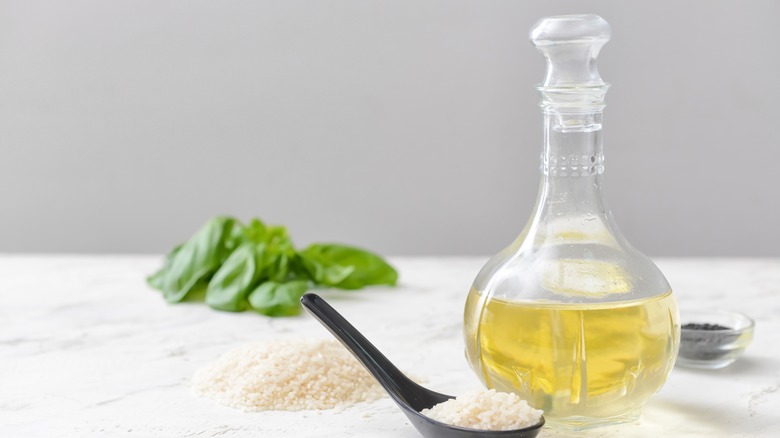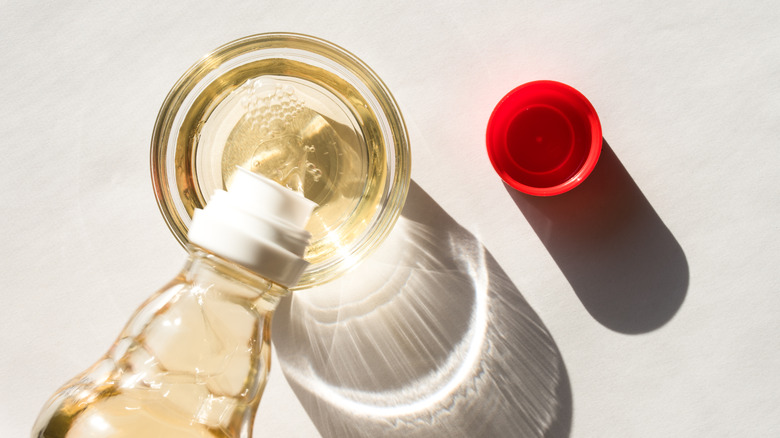The 2 Types Of Japanese Rice Vinegar, Explained
When most people think of Japanese rice vinegar, they think of a clear white vinegar or mirin. While the former is definitely a type of rice vinegar, mirin is actually a viscous rice wine. It is often mistaken for vinegar due to its similarly tangy flavor. However, mirin is much sweeter and lacks the sharp sour flavor of a typical vinegar.
So what are the two types of Japanese vinegar? Well, there's white rice vinegar, which looks like a slightly yellower distilled white vinegar, and brown rice vinegar, which has a light to dark brown tone. White rice vinegar is more well known, as it is used for various Japanese dishes like sushi rice and oshinko, but brown rice vinegar is just as crucial to the cuisine. Like all types of vinegar, rice vinegar is made in two steps of fermentation.
The fermented rice is first made into sake, sake lees, or rice wine. The alcohol content in these products is then fermented into vinegar, which is what accounts for the sour flavor. While white rice vinegar looks similar to the white vinegar we are accustomed to, it is completely different in potency and flavor. Both types of rice vinegar have various uses, making them great ingredients to have in your kitchen.
White rice vinegar
White rice vinegar (junmai-su) is not only a descriptor of the appearance of the vinegar, but also a label for what type of rice the vinegar comes from. The vinegar is brewed and fermented from white rice grains, sans husk and germ, water, and salt, giving it a characteristically savory and sweet flavor. Japanese white rice vinegar is also more mellow in flavor and acidity than distilled white vinegar or apple cider vinegar, which is why it's directly mixed into sushi rice. A little bit goes a long way: The tartness and saltiness of a few tablespoons of vinegar can season a whole basket of sushi rice.
Despite being light-tasting, junmai-su is still acidic, meaning it can be used to pickle vegetables or tenderize meats. In fact, it is usually used to make Japanese sunomono, which literally translates to "vinegar-based dish." Cucumbers, wakame, or any crunchy root vegetables can be dressed in a splash of white rice vinegar for a refreshing side dish. It has a special umami flavor that adds brightness and saltiness to any salad dressing without any added salt or sugar. This type of Japanese rice vinegar is definitely the more versatile and can be used most liberally in different contexts.
Brown rice vinegar
Brown rice vinegar (genmai-su) is brewed from, you guessed it, brown rice. It simply means that the vinegar comes from fermented brown rice, which includes the whole grain with the husk and germ. Interestingly enough, this seemingly small difference gives the vinegar a completely different appearance and flavor to white rice vinegar. The color of genmai-su varies from light to dark brown, and the intensity of the color depends on how long it's been aged. The darker the vinegar, the longer it's been aging, allowing the Maillard reaction to take place between the amino acids and the carbohydrates in the liquid. This process also gives brown rice vinegar a richer malted flavor than white rice vinegar.
Given that genmai-su uses whole grains, it contains more nutrients and amino acids than its lighter counterpart. The flavor profile of this vinegar is perhaps even less acidic than white rice vinegar and more nutty. It could imbue a deeper roasted character to your salad dressing or be used as a part of a dipping sauce for fish and meats. Although it can be used in cooking, many drink it as a health supplement. You could imagine it's a less painful experience than drinking apple cider vinegar, which lots of people do to promote healthy gut bacteria growth. It's definitely more malted and mild in acidity, making it a useful ingredient to have in your kitchen.


